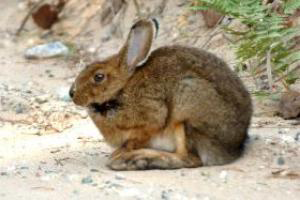Hares, including snowshoe hares, are "precocial:" born largely able to care for themselves. They are fully furred, the eyes are open, and are able to walk at birth. By the fourth day, they forage independently and gather to nurse at dusk.
Photo Credit: Phil Myers
Lepus americanus
Common Name: snowshoe hare
Animal Guild: Mammal
Class > Order > Family: Mammalia > Lagomorpha > Leporidae
What does the species look like?
The snowshoe hare is a good-sized rabbit with enlarged hind feet. They are about 50 cm (18 inches) long and weigh about 1.5 kg (3.25 lb). In most populations, individuals change color from brown-gray in the spring and summer to white in the fall and winter. The range overlaps with several other species of hares, some populations of which also change color with the seasons, but these hares are much larger than snowshoe hares and have a tail that is white on top in summer (brown in snowshoe hare).
Where is the species found?
States & Provinces
AB, AK, BC, CA, CO, CT, ID, MA, MB, MD, ME, MI, MN, MT, NB, NC, ND, NH, NJ, NL, NM, NS, NT, NU, NV, NY, OH, ON, OR, PA, PE, QC, RI, SK, UT, VA, VT, WA, WI, WV, WY, YT
Distribution
The snowshoe hare is distributed across Canada south of the tundra, into the northern U.S. and farther south in the Appalachian, Rocky, and Cascade mountains.
Habitat consists of coniferous and mixed forest and forest edges, especially the vicinity of upland or wetland thickets.
General Phenology and Life History
Snowshoe hares may have as many as 4 litters of young in a season, with the first arriving in mid- to late spring, depending on location. In the fall, the brown coat is replaced with a coat of white-tipped hairs. This coat is shed in the spring for a brown coat. Color change patterns do not always coincide with seasonal changes in snow cover. In parts of the range, especially northwest Canada, populations exhibit strong fluctuations, varying from 0.004 to 39 adults per hectare (1 to 10,000 per square mile) over periods of several years.
Which phenophases should I observe?
Do you see/hear...?
Activity
Live individuals More...
For abundance, enter the number of individual animals observed in this phenophase.
Feeding For abundance, enter the number of individual animals observed in this phenophase.
Development
Young individuals For abundance, enter the number of individual animals observed in this phenophase.
Summer coat For abundance, enter the number of individual animals observed in this phenophase.
Winter coat For abundance, enter the number of individual animals observed in this phenophase.
Dead individuals For abundance, enter the number of individual animals observed in this phenophase.
What do these phenophases look like?
There is currently no photoguide available for this species. If you'd like help us create one, use the guidance document and species template provided here . Then send it via email to education@usanpn.org when it is complete.
